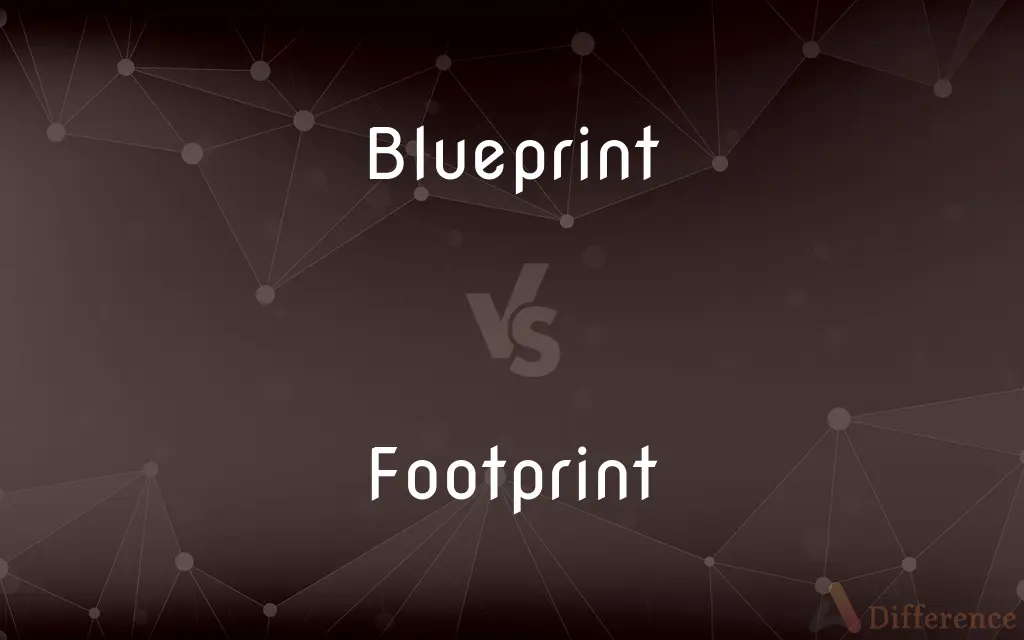Blueprint vs. Footprint — What's the Difference?
Edited by Tayyaba Rehman — By Fiza Rafique — Updated on March 1, 2024
A blueprint is a detailed plan or design of a building or machine, often presented in technical drawings, whereas a footprint refers to the impact or mark left by a foot, or metaphorically, the environmental impact of human activities.

Difference Between Blueprint and Footprint
Table of Contents
ADVERTISEMENT
Key Differences
Blueprints serve as technical guides for constructing buildings, machines, or systems, detailing dimensions, materials, and the layout of components. Footprints, in their literal sense, are the impressions left by feet on a surface, revealing presence or movement. However, the term has evolved to describe broader impacts, most notably environmental.
Blueprints originating from a process that produced blue-background prints, the term now broadly encompasses any detailed plan or design document. These documents are essential in architecture and engineering, providing precise instructions for creating complex structures or devices. The ecological footprint measures the demand on Earth's ecosystems and resources, reflecting the extent of human influence on the planet. It's a metric for assessing how lifestyle, consumption, and production patterns affect the environment, aiming to quantify sustainability and resource use.
The primary distinction between blueprints and footprints lies in their application and significance. Blueprints focus on creation and construction, outlining how things should be made, while footprints are about consequence and impact, often emphasizing the need for sustainability and awareness of ecological effects. One is a tool for bringing designs to life, the other a measure of the environmental cost of those designs and human activities in general.
Both concepts, though different in focus, highlight human ability to shape and influence the environment. Blueprints reflect our capacity for innovation and construction, building environments that cater to our needs and aspirations. Footprints remind us of our responsibility to manage our impact on the planet, encouraging more sustainable practices and decisions. Together, they represent the dual aspects of human creativity and accountability in stewarding Earth's resources.
Comparison Chart
Definition
A detailed plan or design of a structure or system.
The mark left by a foot or the environmental impact of human activities.
ADVERTISEMENT
Purpose
To guide the construction or creation process.
To show presence or impact, especially on the environment.
Application
Architecture, engineering, and design.
Environmental science, sustainability, and personal or corporate impact assessment.
Key Elements
Dimensions, materials, layout.
Ecological demand, carbon emissions, resource consumption.
Outcome
Creation of buildings, machines, or systems.
Awareness and assessment of environmental sustainability.
Compare with Definitions
Blueprint
Schematic design or layout.
Engineers created a blueprint for the new engine design.
Footprint
Space occupied by an object or structure.
The new building has a smaller footprint to conserve land.
Blueprint
Plan or strategy for achieving an objective.
The campaign's blueprint outlined steps for reaching the target audience.
Footprint
Environmental impact of human activities.
Companies are working to reduce their carbon footprint.
Blueprint
Guide for assembling or building a product.
The DIY furniture came with a blueprint for easy assembly.
Footprint
Measure of resource consumption.
Reducing your ecological footprint can contribute to sustainability.
Blueprint
Framework or model to be followed.
The software development blueprint was approved for the next phase.
Footprint
Mark left by a foot on a surface.
The sandy beach was covered in footprints.
Blueprint
A detailed technical drawing for construction.
The architect studied the blueprint before starting the renovation.
Footprint
Digital or electronic trace.
The investigation focused on the suspect's digital footprint.
Blueprint
A blueprint is a reproduction of a technical drawing or engineering drawing using a contact print process on light-sensitive sheets. Introduced by Sir John Herschel in 1842, the process allowed rapid and accurate production of an unlimited number of copies.
Footprint
Footprints are the impressions or images left behind by a person walking or running. Hoofprints and pawprints are those left by animals with hooves or paws rather than feet, while "shoeprints" is the specific term for prints made by shoes.
Blueprint
A contact print of a drawing or other image rendered as white lines on a blue background, especially such a print of an architectural plan or technical drawing. Also called cyanotype.
Footprint
An outline or indentation left by a foot on a surface. Also called footmark, footstep.
Blueprint
A mechanical drawing produced by any of various similar photographic processes, such as one that creates blue or black lines on a white background.
Footprint
The impact that a particular activity, person, or group has on the environment.
Blueprint
A detailed plan of action.
Footprint
The impression of the foot; a trace or footmark; as, "Footprints of the Creator."
Blueprint
A detailed technical drawing (now often in some electronically storable and transmissible form).
Footprint
A mark of a foot or shoe on a surface;
The police made casts of the footprints in the soft earth outside the window
Blueprint
Any detailed plan, whether literal or figurative.
Footprint
A trace suggesting that something was once present or felt or otherwise important;
The footprints of an earlier civilization
Blueprint
To make a blueprint for.
The architect blueprinted the renovation plan once the client had signed off.
Footprint
The area taken up by some object;
The computer had a desktop footprint of 10 by 16 inches
Blueprint
Something intended as a guide for making something else;
A blueprint for a house
A pattern for a skirt
Common Curiosities
Why are blueprints important in construction?
Blueprints are crucial for ensuring that structures are built accurately, safely, and in compliance with design specifications and regulations.
Can the concept of a footprint apply to digital activities?
Yes, the term "digital footprint" describes the trail of data left by interactions in a digital environment, including internet use.
How can individuals reduce their ecological footprint?
Individuals can reduce their ecological footprint by consuming less, recycling, using energy-efficient products, and choosing sustainable transportation options.
What is a blueprint used for?
A blueprint is used as a detailed plan or guide for constructing buildings, creating machines, or implementing systems.
Are blueprints only physical documents?
While traditionally physical, blueprints now also exist in digital formats, using computer-aided design (CAD) software.
Why is measuring your footprint important?
Measuring your footprint is important for understanding personal or organizational impact on the environment, guiding efforts to reduce it.
How is a footprint defined in environmental terms?
In environmental terms, a footprint refers to the impact of human activities on the planet, including resource consumption and carbon emissions.
What factors contribute to a larger ecological footprint?
Factors include high consumption levels, reliance on fossil fuels, waste production, and inefficient use of resources.
What is the significance of a building's footprint?
A building's footprint indicates the area it occupies on land, affecting land use, ecological impact, and spatial planning.
How do architects and engineers use blueprints?
They use blueprints to detail and communicate design intentions, ensuring accurate construction and implementation of features.
Can a footprint be positive?
While often associated with negative impacts, the concept of a "positive footprint" can refer to beneficial environmental actions, like reforestation.
How are blueprints created?
Blueprints are created by architects and engineers using technical drawings and CAD software to detail every aspect of a design.
What does it mean to leave a carbon footprint?
It means to produce carbon dioxide emissions through activities like driving, using electricity, or manufacturing, contributing to climate change.
How does a digital footprint affect privacy?
A digital footprint can affect privacy by making personal information more accessible and potentially misused if not carefully managed.
What role do blueprints play in innovation?
Blueprints serve as a foundational step in bringing innovative designs and ideas from conception to reality.
Share Your Discovery

Previous Comparison
Mastic vs. Mortar
Next Comparison
Propeller vs. ScrewAuthor Spotlight
Written by
Fiza RafiqueFiza Rafique is a skilled content writer at AskDifference.com, where she meticulously refines and enhances written pieces. Drawing from her vast editorial expertise, Fiza ensures clarity, accuracy, and precision in every article. Passionate about language, she continually seeks to elevate the quality of content for readers worldwide.
Edited by
Tayyaba RehmanTayyaba Rehman is a distinguished writer, currently serving as a primary contributor to askdifference.com. As a researcher in semantics and etymology, Tayyaba's passion for the complexity of languages and their distinctions has found a perfect home on the platform. Tayyaba delves into the intricacies of language, distinguishing between commonly confused words and phrases, thereby providing clarity for readers worldwide.
















































